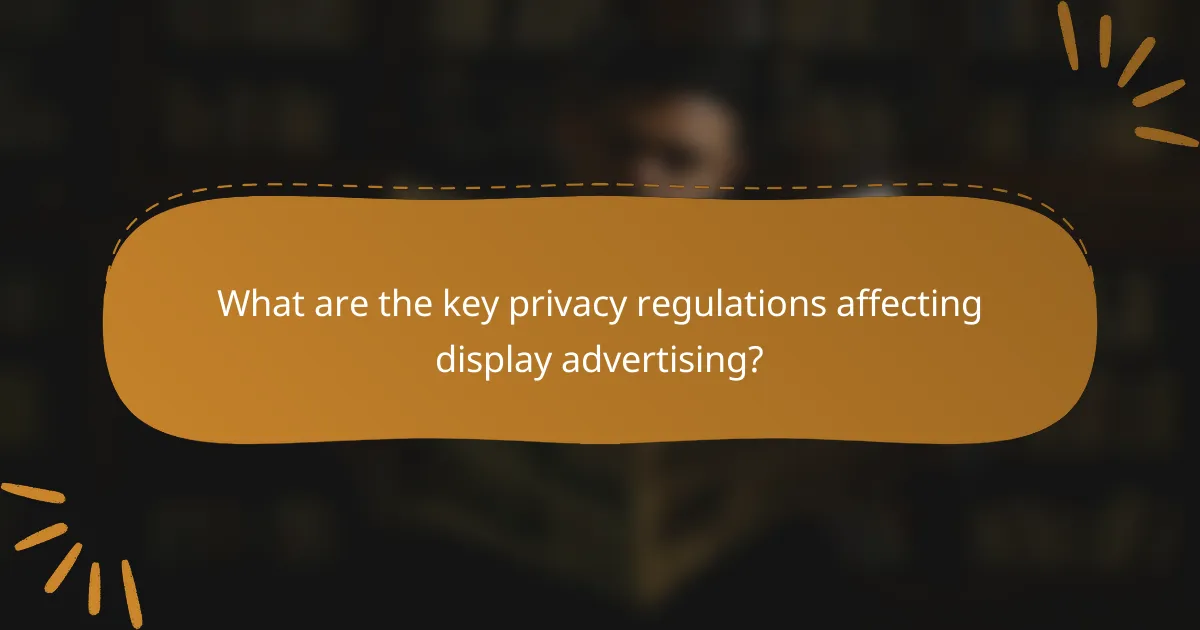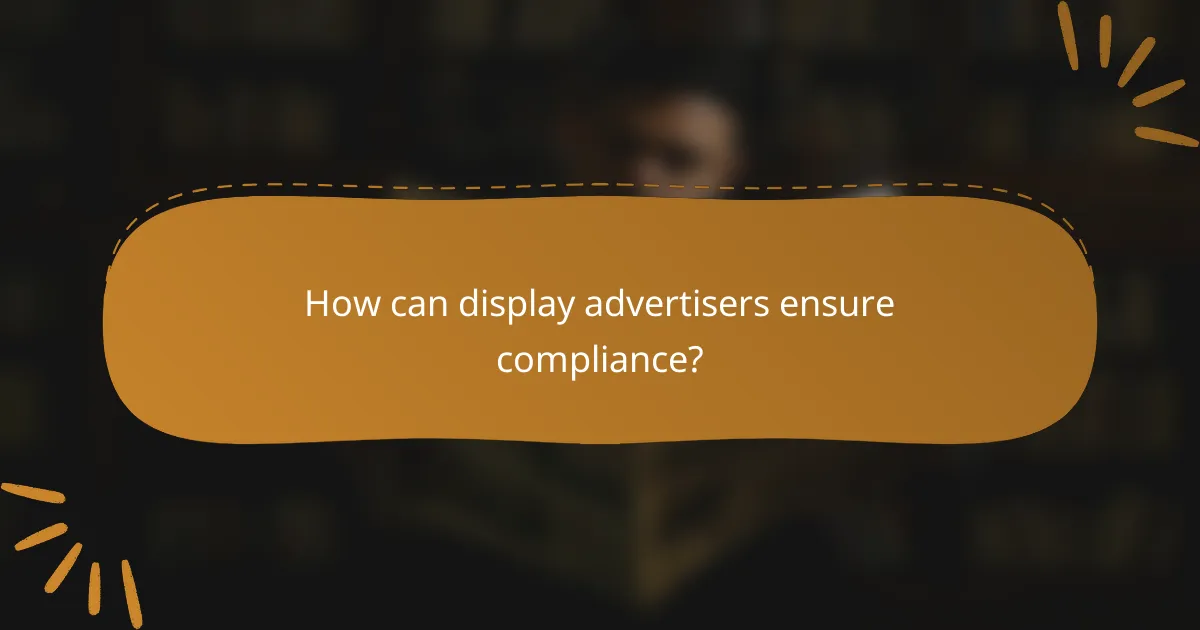In the evolving landscape of display advertising, understanding and adhering to privacy regulations such as GDPR and CCPA is crucial for compliance and consumer trust. Advertisers must implement effective strategies that manage user consent, ensure transparency, and protect user data to avoid potential penalties. By prioritizing robust privacy practices, businesses can navigate regulatory challenges while fostering positive relationships with their audience.

What are the key privacy regulations affecting display advertising?
Key privacy regulations impacting display advertising include the GDPR, CCPA, ePrivacy Directive, COPPA, and HIPAA. These laws set standards for data collection, user consent, and privacy rights, requiring advertisers to implement compliance strategies to avoid penalties.
General Data Protection Regulation (GDPR)
The GDPR is a comprehensive data protection regulation in the European Union that governs how personal data is collected, processed, and stored. It mandates that advertisers obtain explicit consent from users before processing their data, and it grants individuals the right to access, rectify, or delete their personal information.
To comply with GDPR, display advertisers should implement clear privacy policies and consent management tools. Regular audits of data handling practices are essential to ensure adherence to the regulation.
California Consumer Privacy Act (CCPA)
The CCPA provides California residents with rights regarding their personal information, including the right to know what data is collected, the right to delete data, and the right to opt-out of data selling. Advertisers must inform users about their data practices and provide an easy way to exercise these rights.
To comply with CCPA, businesses should update their privacy notices and establish mechanisms for consumers to opt-out. Failure to comply can result in significant fines, so proactive measures are crucial.
ePrivacy Directive
The ePrivacy Directive complements the GDPR by focusing specifically on electronic communications and privacy. It requires consent for cookies and similar tracking technologies used in display advertising, emphasizing user privacy in online interactions.
Advertisers should ensure that they obtain informed consent before deploying cookies. Implementing clear cookie banners and providing users with options to manage their preferences can help meet ePrivacy requirements.
Children’s Online Privacy Protection Act (COPPA)
COPPA is a U.S. regulation that protects the privacy of children under 13 by requiring parental consent before collecting personal information from them. Display advertisers targeting children must adhere to strict guidelines to ensure compliance.
To comply with COPPA, advertisers should implement age verification processes and obtain verifiable parental consent. Failure to comply can lead to hefty fines and reputational damage.
Health Insurance Portability and Accountability Act (HIPAA)
HIPAA regulates the handling of protected health information (PHI) in the U.S. For display advertising in the healthcare sector, compliance with HIPAA is critical when using patient data for targeted advertising.
Advertisers must ensure that any use of PHI is authorized and that appropriate safeguards are in place to protect sensitive information. Regular training on HIPAA compliance for marketing teams can help mitigate risks associated with data breaches.

How can display advertisers ensure compliance?
Display advertisers can ensure compliance by implementing robust privacy strategies that align with regulations like GDPR and CCPA. These strategies include managing user consent, conducting regular audits, employing data anonymization techniques, and maintaining transparent data collection practices.
Implementing consent management platforms
Consent management platforms (CMPs) help advertisers obtain and manage user consent for data collection and processing. These tools provide users with clear options to accept or decline cookies and tracking technologies, ensuring compliance with privacy laws. Selecting a CMP that integrates seamlessly with your advertising tools is crucial for effective implementation.
When choosing a CMP, consider features like user-friendly interfaces, customizable consent banners, and analytics capabilities. Regularly updating your CMP to reflect changes in regulations will help maintain compliance and build trust with users.
Regular privacy audits
Conducting regular privacy audits allows advertisers to assess their data handling practices against current regulations. These audits should evaluate data collection methods, storage practices, and sharing protocols to identify potential compliance gaps. Establishing a routine audit schedule, such as quarterly or bi-annually, can help keep your practices aligned with evolving laws.
During audits, involve cross-functional teams to ensure comprehensive reviews. Document findings and implement corrective actions promptly to mitigate risks associated with non-compliance.
Data anonymization techniques
Data anonymization techniques help protect user identities while still allowing for valuable insights. Methods such as data masking, aggregation, and pseudonymization can reduce the risk of exposing personal information. Implementing these techniques can enhance compliance by minimizing the amount of identifiable data collected and stored.
Consider using anonymization in conjunction with data analytics to derive insights without compromising user privacy. Regularly review and update your anonymization methods to stay ahead of regulatory requirements.
Transparent data collection practices
Transparency in data collection practices builds user trust and aids compliance. Advertisers should clearly communicate what data is collected, how it will be used, and who it will be shared with. Providing detailed privacy notices and easily accessible opt-out options can enhance user confidence in your practices.
Regularly review and update your privacy policies to reflect any changes in data practices or regulations. Engaging with users through feedback mechanisms can also help improve transparency and address any concerns they may have regarding data usage.

What are the best practices for user consent in display advertising?
Best practices for user consent in display advertising focus on transparency and user control. Implementing clear mechanisms for obtaining consent, providing granular options, and ensuring easy opt-out processes are essential for compliance and building trust with users.
Clear opt-in mechanisms
Clear opt-in mechanisms are vital for obtaining user consent in display advertising. This can include checkboxes or toggle switches that explicitly ask users to agree to data collection and targeted advertising. Ensure that these options are easily accessible and not buried within lengthy terms and conditions.
For example, a website might present a pop-up that clearly states, “We use cookies to personalize ads and analyze traffic. Do you consent to this?” This straightforward approach helps users make informed decisions.
Granular consent options
Granular consent options allow users to choose what types of data they are comfortable sharing. Instead of a single blanket consent, provide choices such as opting in for personalized ads, analytics, or marketing communications separately. This empowers users and increases the likelihood of obtaining consent.
For instance, a consent form could include checkboxes for “Personalized Ads,” “Performance Tracking,” and “Newsletter Subscription,” enabling users to tailor their preferences according to their comfort level.
Easy opt-out processes
Easy opt-out processes are crucial for maintaining user trust and compliance with privacy regulations. Users should be able to withdraw their consent as easily as they provided it, ideally with a single click or through a clear link in advertisements or settings.
For example, including an “Unsubscribe” link in email communications or a “Manage Preferences” option on a website allows users to quickly change their consent status. This transparency fosters a positive relationship between advertisers and users.

How do privacy regulations impact targeting strategies?
Privacy regulations significantly affect targeting strategies by limiting the use of personal data and requiring greater transparency. Advertisers must adapt their approaches to comply with these regulations while still effectively reaching their audiences.
Limitations on third-party cookies
Many privacy regulations restrict the use of third-party cookies, which are commonly used for tracking user behavior across websites. This limitation reduces advertisers’ ability to gather data on potential customers, making it harder to create tailored ads. As a result, businesses must explore alternative methods for audience targeting.
For example, with the decline of third-party cookies, companies may need to rely more on direct relationships with users, encouraging them to opt-in to data sharing through clear value propositions.
Shift towards contextual targeting
As privacy regulations tighten, there is a noticeable shift towards contextual targeting, which focuses on the content of the webpage rather than user behavior. This method allows advertisers to display relevant ads based on the context in which the user is currently engaged, without relying on personal data.
Contextual targeting can be effective in reaching audiences who are interested in specific topics, as it aligns ads with the content being consumed. For instance, an ad for hiking gear may appear on a travel blog, capturing the attention of outdoor enthusiasts without tracking their browsing history.
Increased focus on first-party data
With the restrictions on third-party cookies and the rise of privacy regulations, businesses are increasingly prioritizing first-party data. This data, collected directly from users through interactions on a company’s own platforms, is invaluable for creating personalized marketing strategies.
To effectively utilize first-party data, companies should focus on building trust with their customers. This can be achieved by offering incentives for data sharing, such as discounts or exclusive content, and ensuring transparent communication about how their data will be used. By leveraging first-party data, businesses can maintain compliance while still delivering targeted advertising.

What tools can help with compliance in display advertising?
Several tools can assist businesses in navigating compliance in display advertising, particularly concerning privacy regulations. These tools help manage user consent, ensure data protection, and streamline compliance processes.
OneTrust for privacy management
OneTrust is a comprehensive privacy management platform that helps organizations comply with various regulations, including GDPR and CCPA. It offers features such as data mapping, risk assessment, and incident management, allowing businesses to maintain transparency and accountability in their data practices.
By utilizing OneTrust, companies can automate compliance workflows and generate reports that demonstrate adherence to privacy regulations. This can significantly reduce the risk of non-compliance penalties, which can reach substantial amounts depending on the jurisdiction.
TrustArc for compliance solutions
TrustArc provides a suite of compliance solutions tailored to help businesses manage privacy risks effectively. It offers tools for privacy assessments, data inventory, and ongoing monitoring, ensuring that advertising practices align with legal requirements.
TrustArc’s platform is particularly useful for organizations looking to implement privacy by design principles. By integrating compliance into their display advertising strategies, businesses can enhance consumer trust and protect their brand reputation.
Cookiebot for consent management
Cookiebot specializes in consent management, allowing websites to comply with cookie regulations like GDPR and ePrivacy Directive. It provides a user-friendly interface for managing cookie consent banners and preferences, ensuring that users are informed about data collection practices.
Implementing Cookiebot can help businesses avoid fines associated with non-compliance while improving user experience. By clearly communicating cookie usage and obtaining explicit consent, companies can build trust with their audience and enhance their display advertising effectiveness.

What are the consequences of non-compliance?
Non-compliance with privacy regulations in display advertising can lead to significant financial penalties, legal actions, and reputational damage. Companies may face fines that can reach millions of dollars, depending on the severity of the violation and the jurisdiction.
Financial penalties
Financial penalties for non-compliance can vary widely based on the specific regulation and the scale of the violation. For instance, under the General Data Protection Regulation (GDPR), fines can be up to 4% of a company’s global annual revenue or €20 million, whichever is higher. In the U.S., fines for violations of the California Consumer Privacy Act (CCPA) can range from $2,500 to $7,500 per violation.
Organizations should budget for potential fines as part of their compliance strategy. Regular audits and compliance checks can help mitigate the risk of incurring these costs.
Legal actions
Non-compliance can also result in legal actions from consumers or regulatory bodies. Individuals may file lawsuits for damages if their privacy rights are violated, leading to costly legal battles. Additionally, regulatory agencies can initiate investigations that may result in further legal repercussions.
To avoid legal issues, companies should implement robust compliance programs that include regular training for employees on privacy regulations and best practices.
Reputational damage
Reputational damage is another serious consequence of non-compliance. Consumers are increasingly aware of privacy issues and may choose to avoid businesses that do not protect their data. A single data breach or violation can lead to a loss of trust, which can have long-term effects on customer loyalty and brand image.
To protect their reputation, businesses should prioritize transparency in their data practices and communicate clearly with customers about how their information is used. Building a strong privacy framework can enhance consumer confidence and loyalty.
